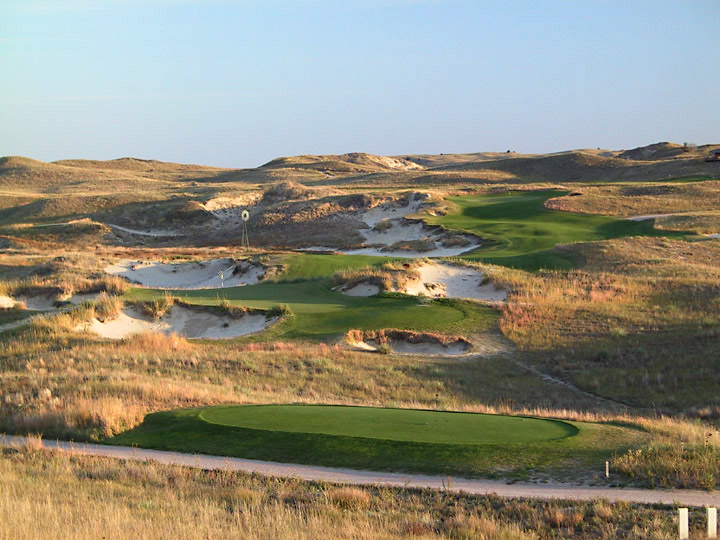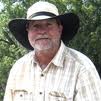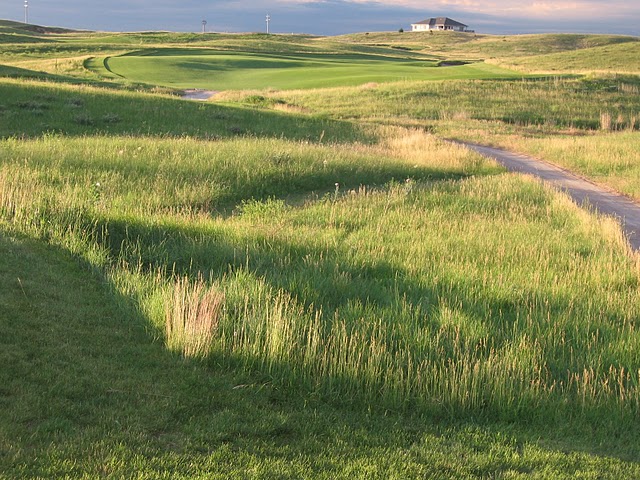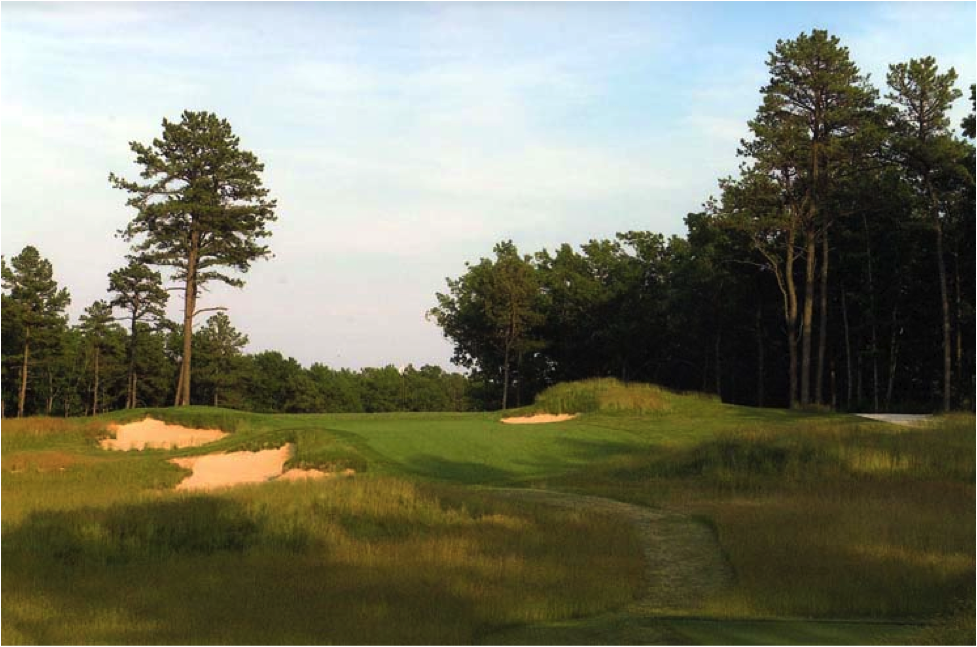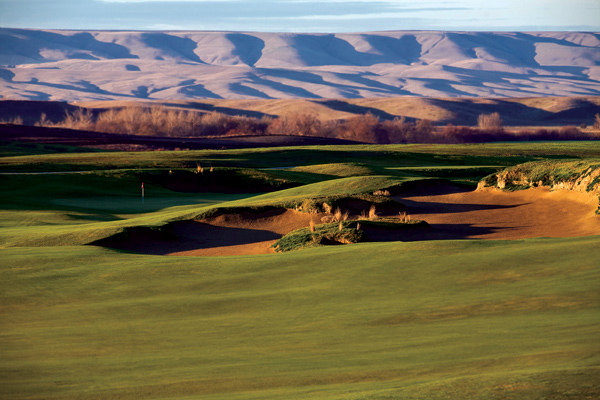Dan Proctor and business partner Dave Axland operate a small golf course design-build firm called BunkerHill Golf, Inc. They’re better known throughout the industry, however, for being the lead construction and shaping specialists on some of Bill Coore and Ben Crenshaw’s best-known courses, including Sand Hills in Mullen, Nebraska, as well as the creators of one of the most highly rated modern American courses, Wild Horse Golf Club in Gothenburg, Nebraska.
I spoke to Proctor, who lives in Texas, in April 2010 for a story I wrote recently about Wild Horse for The A Position and The Duncan List. He was scheduled to soon return to the delayed construction of a new project in North Georgia he and Axland were in the middle of building, Blue Ridge Golf & River Club. Hampered like most new course development by crumbling, off and on again financing, Blue Ridge, if completed, would be the most high profile course Proctor and Axland have authored since Wild Horse in 1998 and Bayside near Ogallala, Nebraska, in 2001.
When not busy with BunkerHill projects, Proctor now contracts independently. He’s recently been busy with renovation work at Prairie Dunes and new construction at Wine Valley Golf Club outside Walla Walla, Washington. This summer he will begin work on a renovation project with Tom Lehman in Minnesota and continues to nurse a new course in Colby, Kansas, through the standard myriad of start-up issues and which, he says, if it gets built will “put Colby on the golf map.”
He spoke to me about how he got into golf course architecture, his work with Coore and Crenshaw, design thoughts, and why he and Axland, for all their efficiency and accolades, have struggled to get premium commissions on their own.
How did you get into golf course construction?
I was working in a golf shop in East Texas—this was 30 years ago—and I started doing some part time work on the golf course and really liked it. So I went to work for a guy name Bill Coore who was a golf course superintendent—that was a course called Water Wood in East Texas. Bill was always into golf course architecture and he started doing some work on his own and I just worked for him for years.
I just kind of branched out on my own. I noticed that small towns and small developers weren’t getting a very good product because they couldn’t afford an architect or designer, so they’d fumble through it and try to do it themselves, so I thought, well there’s a market there if I could tap into it, more of a smaller market.
What was your background working equipment? At that point you must have been pretty proficient on tractors and bulldozers.
We learned to operate just about anything during the bigger projects, so when we started doing the smaller projects we kind of cut out the middleman and the contractor—we’re the designer, contractor, builder, shaper, so we’re just doing it ourselves and it cuts the cost quite a bit and allows us some creative freedom. We pretty much knew how to run the equipment through the bigger projects (with Bill Coore) as younger men, Dave Axland and I.
The last few years I’ve been predominantly doing my own work. Business sometimes doesn’t support both of us, and Dave, he became a little more valuable to Coore and Crenshaw in that he wasn’t just running equipment but he could run jobs and do budgets, and I never got into the jobs and budget aspect of it. Dave also is one of the best shaper/designers on equipment, so he’s also valuable that way.
Did you meet Dave at the same time you met Bill?
I met Dave at Kings Crossing (in Corpus Christi), which was one of Bill’s first solo works. He did Rockport Country Club on his own, then he did Kings Crossing, and it wasn’t too long after that that he joined up with Ben, and they’ve been together since then.
Did you and Dave hit it off right away? How did your partnership evolve?
Dave and I used to hang out at Kings Crossing and talk about doing work (together). I used to joke and say, ‘I’m going to find us a job,’ and I don’t think he ever took me seriously. Finally in 1988, I think, I found this project in Central Texas in this small town (Burnet) that needed some help. We wound up doing that job—we didn’t start to work until 1990. For two years we fumbled around with trying to get it off the ground, doing the routing, and we were both working elsewhere at the time.
Is that course Delaware Springs?
Yes, Delaware Springs. It’s been so long and you forget why you do things, but the main objective there in my mind was, if we do a very good facility for a very good price, we’ll get more work. Well, it doesn’t work that way in this business.
For various reasons your work doesn’t always get you work. It’s still a name business. The client, whoever it is—the developer or municipality—they don’t do their homework to try to select somebody so they’re easily swayed one direction or another. So your work, no matter how good it is or how much money you can save them throughout the project, doesn’t always get you more work. If anything, our work was so affordable and so under the radar cost-wise, it may have hurt us because (prospective clients) thought we didn’t spend enough.
Your cost devalued the product in their eyes.
Yeah. But we continued to work with Bill and Ben in the ’90’s and did a little work on the side, and Gothenburg didn’t start until ’97, I think. But we stayed busy.
It was always your intention to always be an architect/builder rather than just a builder?
Right, right. As much as anything it was a creative outlet. If I didn’t do some of my own work—even though Bill and Ben gave me a lot of creative license, it’s having that final say on a product that means a lot to me, and I think today too. It almost becomes a job if you don’t have final say. It’s about whoever has final say, and then you really feel like you’re being creative.
Explain how it works with Bill and Ben. At what point do you and Dave, and I guess the other guys too, at what point to you enter the process?
With Bill and Ben you’re pretty much involved from day one. The guy running the job will be involved from day one. The shapers will come in before the project starts and get to know the ground, walk the ground with Bill and Ben, and immediately you get a feel for what they see. But they allow stuff to happen on their projects, which gives the shapers some creative room. Of course they come in behind you and change anything they want, but it’s a very hands on [process].
When you’re involved with them, what are some of your primary responsibilities? If I showed up on site, what would Dan Proctor be doing?
I haven’t done anything with them except some bunker work for the last several years, but I guess in the busier days you would say I would do whatever needed to be done…a utility player. It didn’t bother me to do whatever task they needed done. Sometimes guys get locked in to doing one thing and they think that’s what they should do on every project, but I always considered it a blessing just to be involved because they were just fun to do and the people were fun to hang out with.
At Sand Hills I hauled dirt to the greens with a big loader because basically there was no one else to do it, so I said, ‘Well I’ll do it. I don’t mind.’ And you couldn’t take a dump truck out there and haul dirt—it was sand, basically—so we’d just make a pit out of view somewhere in a blow out or somewhere that might become a bunker later, (and) you just steal sand and take it to the greens, tees, take it a bunker if you need it. So I did that for months and I was glad to do it.
So early on you helped build golf courses and then it became your goal, with Dan, to design them as well. I’m curious to know about your learning curve about how to route a golf course—how were you able to go from someone who operated equipment for others to routing a golf course?
I think it was partly just the time. Initially when I worked with Bill Coore when he was a superintendent we would talk about golf course architecture. We would ride to work together and I’d ride home with him and I’d eat lunch with him and we’d talk about architecture constantly, what makes a good hole, what constitutes good golf, just talking and talking about it. But I almost feel like from early on, because I grew up playing golf, that I had the ability or disease or the blessing to see holes in the native ground. When I’m driving down the road I see golf holes. Probably a lot of people do this, ‘Oh there’s a golf hole,’ but I’m constantly looking for golf holes.
But it’s not that easy once you get a site. You get to know it as well as you can, you walk it—we haven’t really used maps that much in our whole process, it’s mainly just walking the ground. I think you can do a basic routing on paper but when you get out to the ground it may be totally something you don’t want. It’s a process. Maybe you find one green site you want to get to so that might determine a five-hole series or a nine-hole series, just getting back to that one green site that really is good.
You talk about, really, routing from what’s kind of instinct, just trying to see holes in the earth. But now, just by working with Bill on, to be honest, some of the greatest golf sites in the last 50 years that have been built on, that must have some influence on you as well, just being around that process.
Well, those sites are almost to the point that the holes scream out at you. If it’s a really good site its harder to kick out holes than it is to find holes. But it’s still not an easy process. I think Bill and Ben went through 100 or so holes at Sand Hills before they found 18 that would work. There were holes in every direction. Have you been out there?
Yes. In the clubhouse they have some old hand sketches and maps that are just littered with holes that they’d found and sketched. I think Bill said they had about 130.
It’s kind of comical that after they had all these holes, the 14th green and 15th tee, I think, weren’t even on the property, if I remember right. After having all that land they still had to buy more just to build that green and tee. Dick (Youngscap) likes to tell that story.
It’s not easy but it’s fun, and if you just let your imagination go and try to see it finished in your mind as you’re walking around, I think that becomes part of the process. You can [start] to see grades and the height of the greens. But I must say here that I’m not in Bill Coore’s league when it comes to routing golf courses. He’s one of the best ones ever.
Aside from Sand Hills, I’m curious to know what’s been your favorite site or favorite project?
Well, it’s not quite as dynamic as Sand Hills, but I love the golf at Wild Horse, from day one. Not to toot our horn but that was a fun piece of ground. (We) knew you could build something very walkable and fun to play.
It’s funny, one of my favorite sites they’ve done, and I didn’t work on it, was Friars Head (on Long Island). I saw it in the beginning, I saw it in the middle and I saw it in the end. It’s just quite a (place) and I just couldn’t believe what they had going there. I’d have to say even as something as simple as Hidden Creek (New Jersey), which I did work there, it just turned out to be a fun (project). They really incorporate fun into the game and it’s in all their projects. And that’s what we learned too—it has to be fun or people won’t enjoy it. It can be tough but it has to be fun tough. There’s a fine line between too severe and tough fun. That’s tough to explain to people sometimes.
I’m curious if you would have had the chance to built Wild Horse before you worked at Sand Hills, or even back in the late ’80’s when you were getting started, would you have built the same course or have your design tastes evolved?
It wouldn’t have been as good, I don’t think. I’ve been doing this a long time and I’m a better equipment operator now than I was 10 years ago, so there’s levels, and your eyes are better. I don’t know, that’s a tough question.
Have you always had the same strategic sense? One of the great things about Wild Horse is that it’s so wide and really sets up different angles and different lines off the tee—has that always been something that you’ve been attracted to?
If I’ve learned anything from Bill and Ben it’s to give golfers choices. Instead of forcing them to play to a certain direction, give him choices in how he’s going to play the golf hole. So you have to be wide. But angles? I would have to say Dave has a great talent for angles. He’s really good at angles. My angles tend to be sharper and Dave has softer, better angles, so we’re a good team that way.
You mentioned before about how some of the sites you worked with Bill and Ben, the holes were just screaming to be built. Wild Horse is a good site but certainly not on that level, but because it’s not a world class site it’s proof you can build a world class course on a good but not great property. How easy or difficult was it to route?

Bayside Golf Course, near Lake McConaughy in Nebraska, blends into the folds of the rugged western Plains.
One thing that people don’t realize about building a golf course even if the ground is really good, you end up building the greens. At Wild Horse all the material for the greens came out of that hole up there at the parking lot, so you can see there’s a lot of material on those green sites, and some of the tees too. So there’s a lot of building going on, and it’s not easy to build it and make it look like it was there. That’s what you’re trying to do, is make it look like it’s been there forever.
We had a few natural (green) sites at Gothenburg but they needed dirt, they needed material to make them what they are. We did a lot of building. I think Gothenburg had some really good natural holes that just needed to be helped a little bit.
You can go overboard. I can honestly tell you, when I left there I told a friend of mine, Rod Whitman, who’s a very talented designer, ‘I told Rod I don’t think we did enough.’ But as it turns out we did enough, and if we’d have done more it would have looked contrived.
Some of those things happen by accident. The bunkers on number three, Dave went down—there were little rises in the fairway—and he went down there and stole some native grasses to put on some bunkers (the bunker between two and three). Then a couple of days later, when he was gone, I went over there and I thought he was starting on some bunkers, so I went ahead and built those bunkers. Dave comes back and says, ‘I like the way you put those bunkers there,’ and I said ‘I thought you had started them,’ and he says, ‘No, I just stole some native.’ But that’s how they turned out to be bunkers. There was no plan there.
I keep going back to how the ownership group (at Wild Horse) was simply looking for a modest course that was better than the one they were playing, and they ended up getting one of the best courses in the country.
I would go to meetings in Gothenburg—like the Lions Club, or the golf association—and I would tell them, ‘You all are going to have one of the best courses in the state of Nebraska, and maybe one of the best in the country, public golf course-wise,’ and they’d look at me like I was out of my mind. And I said, ‘No, I’m serious. This is going to be good.’ They had low expectations.
After all the attention Wild Horse got and continues to get, and with its continued high rankings, can you put your finger on, other than the fact your name isn’t Fazio or Nicklaus, why it didn’t lead to more jobs?
That’s one of the mysteries of the business that I can’t figure out. Partly it’s our own fault that they (the clients) don’t want to hire the guy running the bulldozer. They want the architect standing out there and pointing.
Which is bad business by the way, from the developer’s standpoint, economically.
I’m going through that in Georgia a little bit right now. You know, I’m getting a little older and I want to turn it over to people, somebody else to do the heavy work, run the equipment, but I’m having a hard time letting go because I want to be hands on.
But back to your original question—I always go back to the client: do your homework. If you want a name architect, go look at his work, spend some time with him, see what you’re getting for your money. Then you come spend some time with us and see what you’re getting for your money, But they don’t do that. They’re almost immediately swayed by that big firm that will plop a phone book worth of paperwork on their desk and say, here’s what we offer. They can generate paper.
One of the best examples of the sad state of our business is a course in Kansas called Cottonwood Hills.
Yeah, that’s a newer Nick Faldo project.
Yeah, they spent a ton of money on that thing, got an inferior product, no one wants to play it, it’s barely able to pay its bills, I don’t know what’s going to happen to it. They’re talking about not even opening it this summer. They’re close enough to Wichita and a lot of golfers that, if they’d have spent no more than $3 million on this thing and built something like Wild Horse, very playable, they’d be making money.
It’s a good property, isn’t it? A lot of sand?
Excellent property. It’s a lot like the property at Prairie Dunes. It’s only about five, six miles from (there). I was just by there last week when I was in Kansas and I looked at this thing and said, ‘Man, why not go over to Prairie Dunes and, you don’t have to copy it, but go look at it.’ I don’t know if they did or not. But they just get too top heavy with all these costs and all these people. They didn’t just pay Nick Faldo a design fee, they had two or three other guys they were paying design fees to. So you can imagine how much money they threw out for design fees. Just throwing money away.
This is symptomatic of what’s happened to golf in the last decade. It’s just one example of why golf development has failed so miserably.
Exactly. I would say this, perhaps going back to your question, people ask us ‘Don’t you get a lot of recommendations from Bill and Ben?’ We do, but people who want Bill and Ben don’t want Dan and Dave. That’s the bottom line. If they’re not going to get Bill and Ben they’re going to want whoever, Nicklaus, whoever. Fazio. Palmer.
You did get the job up in Blue Ridge (Golf & River Club) in North Georgia—how did that come about?
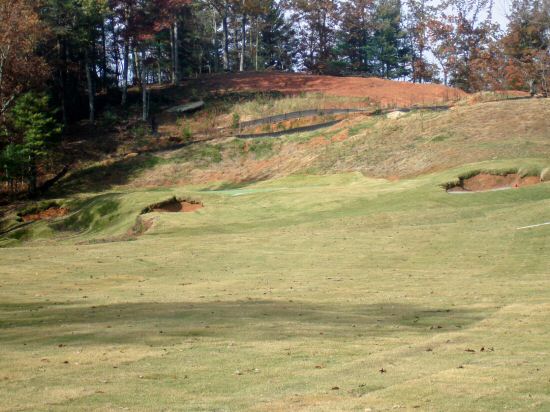
In the construction stage for years, here’s hoping Blue Ridge Golf & River Club is someday completed.
That’s a sad state of affairs. The current owners bought the property after they had started the project…the original owners had hired Tom Jackson, I believe out of North Carolina. He did a routing, and then the people that we’ve been dealing with decided they didn’t want Tom, they wanted us, Dave and I, to do it. They’d worked with us at Old Sandwich, and also as Cuscowilla. So I go down there five years ago and say, look, you guys have some legal obligation to Tom Jackson because he was hired, that’s the way it works. So…they say, well can you and Dave and Tom collaborate?
I say, maybe, but in a long, roundabout way we figured no, we can’t collaborate. He doesn’t have a clue what we do and we don’t have a clue what he does. So we backed away and said, it’s Tom’s project, we’re just going to back away. Well, six months later they buy out Tom and ask us to come back, and we’ve been there ever since and we’ve only finished seven holes [laughs]. In five years.
And this is just like so many projects around the country where it runs out of money, the bottom falls out, and you’re just going to the bank trying to scrap up any loan you can get to re-start it?
Basically that’s exactly where they’re at right now. We were trying to get nine holes finished last summer but we got such a late start we only got seven.
If there were a sudden influx of money into the project, what’s your opinion of its potential?
I’m not a big fan of mountain golf, but for mountain golf our whole objective there was for it to be way more playable than most mountain golf courses. And it’s not your typical mountain course (because) we have holes down by the (Toccoa) River, which give you a break, but you’ve got to come down the mountain and you’ve got to climb back up the mountain. It’s not a huge mountain but it’s steep. You’re constantly trying to get a ball to stay on slopes that you just don’t want.
But I think on the whole it’s going to be more popular as far as mountain courses go than most. I mean, I don’t want this grand illusion that it’s the best thing we’ve ever done because it’s hard, it’s hard to do, but we have some awfully good holes out there and we’re trying to make it look like an old style course with random mounds—it looks old already because it’s been sitting there for so long. It’s not very long—we’ll be lucky to get 6500 yards out of it—but it’s severe.
Does it share any of the same DNA as Wild Horse?
No, I would say no. Somebody might see it but I don’t. It didn’t even enter my mind.
You also did some work out at Wine Valley in Eastern Washington.
Yeah, that was one of my favorite summers-that was a blast. We had a great crew. Dan Hixson, he was the architect and he’s a great guy, a really good player. His whole family are good players. It was a fun summer. I got to change all the greens-that was my duty. They’d rough ’em in and I’d finish them. I had a blast.
Better than hauling sand back and forth, I guess.
One of the reasons I started doing my own stuff too is that I really enjoy finishing the greens. I found out I was pretty good at that and Bill Coore loves doing that (too). So there was really no way I was going (to do) that on that team, so in order to do my own greens I had to do my own (thing). So that’s kind of how that evolved. They’ve got a pretty good product out there. It’s pretty cool.
It’s a neat area near Walla Walla. They get about ten inches of rain a year but they have have plenty of water, ground water and surface water, and anything you put water on grows. It looks like a Garden of Eden when you water. There’s a lot of wheat fields around the golf course and it looks really good. It’s a fun golf course, and when the wind blows it’s tough.

